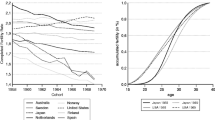Abstract
Measures of Canadian fertility (total fertility rate and fifteen-year age-specific fertility rate F15−29) and relative cohort size (population aged 30–64 years divided by population aged 15–29 years) show a close co-movement between 1940 and 1976 but record a marked departure since then. The application of cointegration techniques to these series (1921–1988) shows that they do not form an equilibrium relationship even over the period 1940–1976. Contrary to the expected relationship between relative cohort size and relative income, income data by age groups show that there is no tight relationship between them. The absence of an equilibrium relationship between relative cohort size and fertility, therefore, does not necessarily imply that Easterlin's hypothesis is false.
Similar content being viewed by others
References
Banerjee A, Dolado JJ, Hendry DF, Smith GW (1986) Exploring equilibrium relationships in econometrics through static models: some monte carlo evidence. Oxford Bull Econ Statist 48:253 -277
Butz WP, Ward MP (1979) The emergence of countercyclical U. S. fertility. Am Econ Rev 69:318–328
Davidson JEH, Hendry DF, Srba F, Yeo S (1978) Econometric modelling of the aggregate time series relationship between consumer's expenditure and income in the United Kingdom. Econ J 88:661–692
Dickey DA, Fuller WA (1979) Distribution of the estimators for autoregressive time series with unit roots. J Am Statist Assoc 74:427–431
Dickey DA, Fuller WA (1981) Likelihood ratio statistics with a unit root. Econometrica 49:1057–1072
Dickey DA, Bell W Miller RB (1986) Unit roots in time series models: tests and implications. Am Statist 40:12–26
Diebold FX, Nerlove M (1988) Unit roots in economic time series: A selective survey. In: Fomby TB, Rhodes GF (eds) Advances in econometrics: Co-integration, spurious regressions, and unit roots. JAI Press, Greenwich, CT, pp 1–94
Dolado JJ, Jenkinson T (1987) Cointegration: A survey of recent developments. Appl Econ Discuss Paper 39, Institute of Economics and Statistics, University of Oxford
Easterlin RA (1980) American population since 1940. In: Feldstein M (ed) The American economy in transition. Chicago University Press, Chicago, pp 275–347
Easterlin RA (1984) A reply to Rutten and Higgs. In: Schultz TP, Wolpin KI (eds) Research in population economics 5:213–215
Easterlin RA, Condran GA (1976) A note on the recent fertility swing in Australia, Canada, England and Walse and the United States. In: Richards H (ed) Population, factor movements in economic development: Studies presented to Bringly Thomas. University of Wales Press, Cardiff, pp 139–151
Engle RF (1987) On the theory of cointegrated economic time series. Discussion Paper 87–26, Department of Economics, University of California, San Diego
Engle RF, Granger CWJ (1987) Co-integration, and error correction: representation, estimation and testing. Econometrica 55:251–276
Engle RF, Yoo BS (1987) Forecasting and testing in cointegrated systems. J Economet 35:143–159
Fuller WA (1976) Introduction to statistical time series. John Wiley, New York
Granger CWJ, Newbold P (1974) Spurious regressions in econometrics. J Economet 2:111–120
Hall A (1989) Testing for a unit root in the presence of moving average errors. Biometrika 76:49–56
Hall A, Hasset K (1989) Testing for unit root using an instrumental variable estimator: a monte carlo investigation. Manuscript, Department of Statistics, North Carolina State University
Harvey A (1989) Forecasting structural time series models and the Kalman filter. Cambridge University Press, Cambridge
Hasza DP, Fuller WA (1979) Estimation for autoregressive processes with unit roots. Ann Statist 7:1106–1120
Hendry DF (1986) Econometric modelling with cointegrated variables: An overview. Oxford Bull Econ Statist 48:201–212
Johansen S (1988) Statistical analysis of cointegration vectors. J Econ Dynamic Control 12:231–254
Johansen S (1989) Estimation and hypothesis testing of cointegration vectors in Gaussian vector autoregressive models. Preprint 3, Institute of Mathematical Statistics, University of Copenhagen
Johansen S, Juselius K (1989) The full information maximum likelihood procedure for inference on cointegration — with application. Discussion Paper 89-11, Institute of Economics, University of Copenhagen
Macunovich DJ, Easterlin AR (1988) Application of Granger-Sims causality tests to monthly fertility data, 1958–1984. J Popul Econ 1:71–89
Nelson CR, Plosser CI (1982) Trends and random walks in macroeconomic time series: some evidence and implications. J Monet Econ 10:139–162
Pantula SG, Hall A (1989) Testing unit roots in autoregressive moving average models: An instrumental variable approach. Manuscript, Department of Statistics, North Carolina State University
Park JY, Choi B (1988) A new approach to testing for a unit root. CAE Working Paper No. 88-23, Cornell University
Phillips PCB, Ouliaris S (1990) Asymptotic properties of residual based tests for cointegration. Econometrica 58:165–193
Rutten A, Higgs R (1984) Graphic tests of Easterlin's hypothesis: science or art? In: Schultz TP, Wolpin KI (eds) Research in Popul Econ 5:201–212
Said SE, Dickey DA (1984) Testing for unit roots in autoregressive moving-average models with unknown order. Biomet 71:599–607
Stock JH (1987) Asymptotic properties of least squares estimators of cointegrating vectors. Econometrica 55:1035–1056
Wachter M (1977) Intermediate swings in labor force participation. Brookings Papers Econ Activity 2:545–576
Wright RE (1989) The Easterlin hypothesis and European fertility rates. Popul Dev Rev 15:107–122
Wright RE, Maxim PS (1987) Canadian fertility trends: a further test of the Easterlin hypothesis. Can Rev Soc Anthropol 24:339–357
Author information
Authors and Affiliations
Additional information
I would like to thank Paul Maxim for allowing me to use his data set for this analysis. My thanks are also due to Peter Smith and three anonymous referees for their constructive comments on this work.
Rights and permissions
About this article
Cite this article
Abeysinghe, T. On testing Easterlin's hypothesis using relative cohort size as a proxy for relative income. J Popul Econ 4, 53–69 (1991). https://doi.org/10.1007/BF00160368
Received:
Accepted:
Issue Date:
DOI: https://doi.org/10.1007/BF00160368




